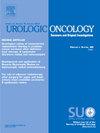Rates of volume reduction after selective arterial embolization for renal angiomyolipoma
IF 2.3
3区 医学
Q3 ONCOLOGY
Urologic Oncology-seminars and Original Investigations
Pub Date : 2025-08-09
DOI:10.1016/j.urolonc.2025.06.021
引用次数: 0
Abstract
Purpose
To characterize temporal patterns of renal angiomyolipoma volume reduction after selective arterial embolization and identify factors predictive of reduction rates
Materials and methods
Records of patients undergoing renal angiomyolipoma embolization from July 2001 to July 2023 at our center were retrospectively reviewed. Tumor measurements were extracted from available imaging, and lipid content was scored based on tumor attenuation characteristics. Rates of volume reduction were compared for tumors at different follow-up intervals. The primary outcome was monthly tumor volume reduction.
Results
Forty-four patients were identified who underwent 77 embolizations for 54 tumors. Of these, 32 patients had available volume data and were included in the analysis of our primary outcome. Tumor volumes decreased significantly faster during the first 6 months after embolization (7.4% per month) compared to years 2 and 3 of follow-up (0.3% per month, P = 0.01 and <0.1% per month, P = 0.01, respectively). Mean tumor size reduction within the first 6 months of initial embolization was 25% lower for patients who ultimately had repeat embolization compared to single-embolization patients. Within the first 6 months, older patients experienced 0.9% lower monthly volume reduction per additional year of age.
Conclusions
Embolized tumors in this cohort involuted rapidly during the first 6 months of follow-up, then stabilized, with the rate of volume reduction approaching 0% per month after 2 years. These data contribute to the understanding of angiomyolipoma embolization outcomes and may help providers avoid unnecessary embolization in patients with stable smaller tumors after 1 to 2 years.
选择性动脉栓塞治疗肾血管平滑肌脂肪瘤后体积减少率。
目的:探讨选择性动脉栓塞后肾血管平滑肌脂肪瘤体积减少的时间模式,并确定减少率的预测因素。材料和方法:回顾性分析本中心2001年7月至2023年7月肾血管平滑肌脂肪瘤栓塞患者的记录。从可用的影像中提取肿瘤测量值,并根据肿瘤衰减特征对脂质含量进行评分。在不同的随访时间间隔比较肿瘤的体积缩小率。主要结果是每月肿瘤体积减少。结果:44例患者接受了54个肿瘤的77次栓塞治疗。其中,32例患者有可用的体积数据,并被纳入我们的主要结局分析。与随访第2年和第3年(每月0.3%)相比,栓塞后的前6个月肿瘤体积下降明显更快(每月7.4%),P = 0.01。结论:该队列中栓塞后的肿瘤在随访的前6个月迅速累及,然后稳定下来,2年后体积缩小率接近每月0%。这些数据有助于了解血管平滑肌脂肪瘤栓塞的结果,并可能帮助提供者避免在1至2年后稳定的较小肿瘤患者进行不必要的栓塞。
本文章由计算机程序翻译,如有差异,请以英文原文为准。
求助全文
约1分钟内获得全文
求助全文
来源期刊
CiteScore
4.80
自引率
3.70%
发文量
297
审稿时长
7.6 weeks
期刊介绍:
Urologic Oncology: Seminars and Original Investigations is the official journal of the Society of Urologic Oncology. The journal publishes practical, timely, and relevant clinical and basic science research articles which address any aspect of urologic oncology. Each issue comprises original research, news and topics, survey articles providing short commentaries on other important articles in the urologic oncology literature, and reviews including an in-depth Seminar examining a specific clinical dilemma. The journal periodically publishes supplement issues devoted to areas of current interest to the urologic oncology community. Articles published are of interest to researchers and the clinicians involved in the practice of urologic oncology including urologists, oncologists, and radiologists.

 求助内容:
求助内容: 应助结果提醒方式:
应助结果提醒方式:


